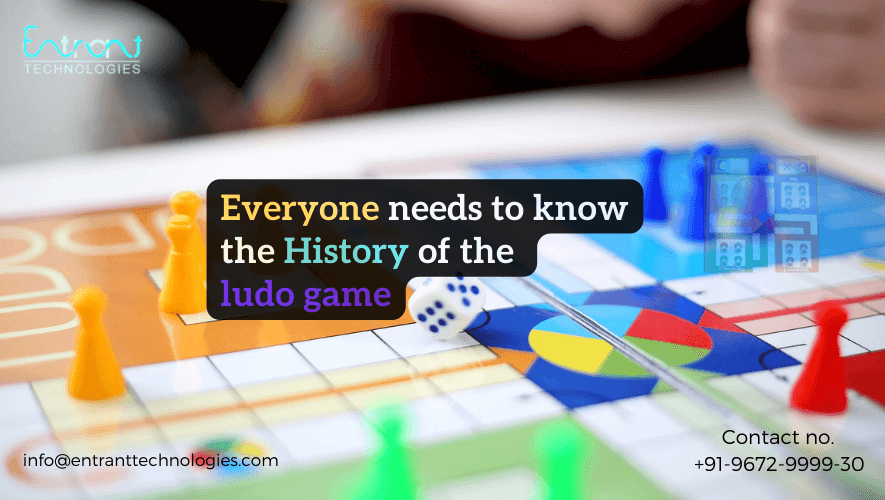
When anyone hears the name of Ludo, they immediately remember how much popularity it has gained in the recent two years including the pandemic. Ludo is one of the most famous games in Indian households and emerged as the most downloaded game in India during the COVID lockdown, surpassing even global favorites such as fortnight and PUBG. It is not only associated with nostalgia, but ludo game developer in india makes legendary game. It has also helped us to create many strategies and tricks that can be useful in real life. Ludo is loved by all, family members and friends alike.
Ludo has long been famous for being the most straightforward board game available on the market. A board to play with, a pair of dice, and up to 4 players can dive straight in for a round of unlimited fun. The game of Ludo has been around for centuries and recently it has gained a lot of recognition in the online gaming market. The game is top-rated, making it fun and playful for people of all age groups with erectile dysfunction.
The exact origins of this mythical game are debatable, although the earliest evidence of the game comes from the historic Ellora Caves in Maharashtra, where the board game was depicted as a wall painting. The familiarity and ease of play along with nostalgia made Ludo one of the most popular games on the internet during the lockdown period. From this, it appears that Ludo was an Indian creation.
For centuries, people have played similar versions of the ludo company game we know today as Ludo. Hundreds of years later, the game can now be played virtually as well on the mobile app, where players can play the game from remote locations. Anyone and everyone can learn the techniques involved in the Ludo game. The fate of the player depends on the number that the player receives when he rolls the dice. The colors of the board are divided into four quadrants such as red, green, blue, and yellow. Let's take a look at some of the other factors that drew millions to this age-old dice game that turned it into an online sensation.
History of the Ludo Game
It is believed that the game of ludo development originated in ancient India. Ludo was known by various names at different times in Indian history, such as 'Chausar', 'Chaupar', or 'Pachisi'. The game eventually became famous around the world in many other popular forms. For instance, the Spanish version of the game was known as 'Parcheesi', the Chinese called it 'Chatush Pada' (meaning four cloths) and it was known in Africa as 'Ludu'.
The earliest evidence comes from the Mahabharata of the Ludo game. The game gained relevance when Mahabharat's character Shakuni used the cursed dice to defeat the Pandavas and lose everything. Yudhishthira makes Draupadi part of the gamble and eventually loses her too. The game of Pachisi was made in India in the 6th century. The historical Ellora caves attest to the existence of the strategy board game Ludo in India.
The popular ludo development game in ancient times was also known as Chaupar. Many former emperors carried the contemporary version of the Pachisi, while the Mughal emperor Akbar is a notable example. Instead of using standard shells or seeds, the emperor used the women as pieces on a life-size board. The Palace Halls of Agra and Fatehpur Sikri are decorated with this game, showing the floorboards.
Historians are not sure how old the game of Ludo is from Akbar, but it is said that some features seem to have been present in Adi India from the 3rd millennium BC. So in fact, Ludo has been present throughout Indian history as some variant of the game has been at the center of each era. Different from Indian history, the board game has evolved from becoming "royal ludo" to reaching all over the world. The original ludo board was changed to a cubic die with a dice cup and it was adopted by the British Royal Navy.
From mythology to history, Ludo development makes its presence everywhere but there was a slight variation. There are also some other references to the game of chausar that date back to the 19th and 20th centuries. Interestingly, Chausar was played with long dice (even stick dice) – these were more common in South and Southeast Asia and were not played with cubic dice.
How was Pachisi apart from Chausar?
Pachisi is often referred to as the Chaupar of the poor. This is because it was traditionally played with cowries (small balls used as money by the very poor as It was not played with stick dice). Historians have studied the equipment used in playing Chaupar and pachisi and found that both long dice and cowries date back to the third millennium B.C. However, some historians believe that Pachisi, an ancestor of Ludo, was built around the sixth century and can be depicted in the Ellora caves of Maharashtra.
History of Ludo's first patent
Ludo's ancestor Pachisi was played with two or three long dice, which were modified by an Englishman known as Alfred Collier. He also introduced a cubic dice with a cup and registered the first ever patent in the history of ludo game development. His version of the game was called "royal ludo" and he set out to patent it in England in 1896.
Ludo has a wonderful history, From a game played on cloth and board using seeds or dice, it has now evolved into mobile games and apps that can be played with friends and family anytime from anywhere in the world. It can be said that out of all the traditional Indian games, Ludo has seen the greatest technological momentum in adoption.
Present Ludo Board
The board as currently known didn't always look like this, nor was it always a simple cardboard or wood pattern. The board has grown throughout the history of ludo game web & app development company, though not as much as the dice did. Is anyone aware that older versions used long rectangular dice in place of the small cubicle and a box that are now much more popular? A brief history of Ludo can be traced through its board as Ludo's predecessor Pachisi was played on a cross and circle pattern.
The board assigns each player a home column or space and is divided into four colors (usually yellow, green, red, and blue). Each home column is separated equally spaced with cross-shaped play spaces that are divided into small arms sections. In the center of the board there is a large finishing square, often made up of four colored triangles indicating each player's exit.
Like most ancient games, Ludo has no officially recognized founder as Ludo has so little history to be excavated. There is not necessarily a lack of information, but apart from having so many versions of the same game, huge gaps exist that it cannot be said who started it all.
Ludo as a game needs no introduction, especially in the South Asian region, as the offline version has been played for centuries. Because ludo is the oldest game in the Indian subcontinent, with a huge fan base. The nostalgia associated with the game's origins has helped it gain immense users in the gaming marketplace and rocketed its popularity. Historically, ludo game development company has had a lasting impact on the lives of the Indian people.
Ludo Rules
Below are the basic ludo rules to understand how to play ludo, which also includes ludo rules for killing.
- To enter a token for play from his yard to his starting square, a player must roll a six or a one on the dice.
- In the Ludo game, the pieces only move forward and the players take turns in a clockwise direction.
- Each player who rolls a six earns a "bonus" turn and if the bonus turn results in a six again, the player rolls again. The third time is not an attraction, as three consecutive sixes in Ludo are said to be invalid.
- You can strengthen your defense by doubling your tokens and creating a "block", which means that if two of your tokens are standing in the same spot, no opponent can hold them until they are each other.
- Each captured token goes back to its yard and can only be re-entered into play if the player hits a six.
Conclusion
Ludo was known by various names at different times in Indian history, such as 'Chausar', 'Chaupar', or 'Pachisi'. Since the beginning of the lockdown, Ludo gaming has been a hit in the online Indian market with millions of downloads. Earlier the Ludo game was limited only to the fence of the house, but the online factor has shown people to rediscover their similarities and attitude towards this age-old game of luck and skill. Moreover, the nostalgia associated with Ludo has made it even more popular in this era of the digital revolution. The availability of the game is easy, and the fact that you can play it anytime, anywhere, makes the ongoing mania of Ludo even more unreal. Ludo game development company Entrant Technologies Pvt Ltd provides the best solution for ludo game development cost in india.


